
8 I - 5 II 2010
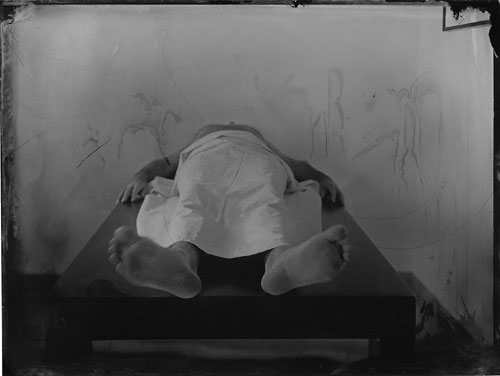
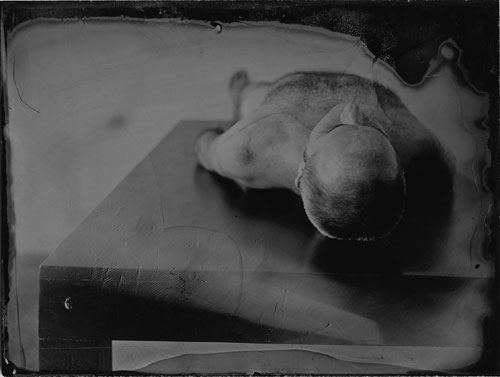
This is the English paraphrase of the first paragraph of the chapter called On My Intention from Czes흢aw Mi흢osz's book Visions from the San Francisco Bay1 which inscribed itself in my memory for a very long time and sometimes returned as an idea for a photograph. Its last sentence became the basic element of my artistic practice. It not only differs stylistically from what comes earlier - "꿢nd I defend myself from the fragility and transitoriness of my body by means of touching the table" - but it is also a clear image of a gesture and a combination of two different artistic ingredients - of the human body and a wooden table.
The body is weaker, soft, it has its specific smell and taste, it is sensual. The table, on the other hand, is harder, more durable, permanent and objective. Putting them together in a contrasting context is an attempt to intensify the labours we undertake to preserve our corporality and sensuality. Moreover, we regard a table to be something like a support, something that we can put many things down on - and the table should survive this operation. Touching something as permanent and hard as a table might slow the passage of time and the disintegration of our transitory corporality, sentenced to exist in a concrete being.
I divided the whole set of works into two series of photographs - the first one refers mainly to still-life, the second one to the subject of transitoriness in the context of my own body. The choice of such subjects marks the struggle with phototechnical matter - through the choice of the wet collodion method as the means of taking photographs - but also the struggle with one's own relation to what it is difficult to distance oneself from and to what is an inherently personal problem. The wet collodion process is a technique which is highly unforeseeable since each plate undergoes individual treatment. The chemical process is not standardized, but the plate is also easily given to artistic provocations and so the resulting image is a corollary of all those manipulations. Each plate full od photographic "waste" - spots, damp patches, traces of collodion emulsion overflowing and later treated with developer - becomes almost thick with emotions, so to say. Each plate is unique due to a specific technique and therefore it suggests its own interpretation of the world. It is subjected to the same laws as all living beings - it is imperfect and always unforeseeable. It defies standardization and all plans as to its final visual effects - it lives its own life and sometimes leads the author down its own road. It is magical and fastidious. Simple and complex. It includes many processes that border on alchemy. After all, its is light-sensitive...
I end this series of works with a fragment of a poem called The Sun of America from a book of poems by Adam Zagajewski, entitled Antennas :
" [...]
In a dark room at the table
Sits an older man
And thinks of what he's lost
And what he's preserved
I am this man
I guess what I'll lose in the future
But I don't know what I'll find."
Marek Szyryk
Translated by Maciej 힃wierkock
Translated by Maciej 힃wierkock
2 Zagajewski Adam, Anteny, Wydawnictwo a5, Cracow 2005.
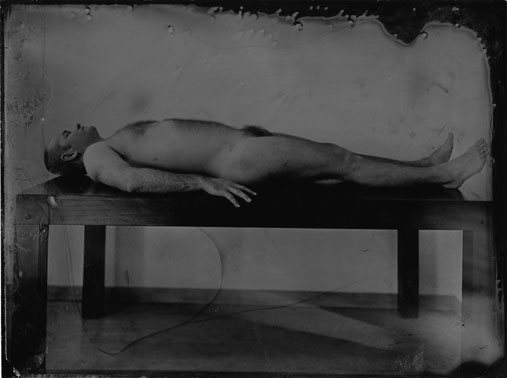


"Collodion, an essential chemical substance in use before 1870 is still used in the army to produce explosives, but also by doctors to dress wounds." 1
We should remember that the wet collodion method2, designed in 1851 by Frederick Scott Archer, gained popularity because it was at the time the most effective means of producing photographic images and in spite of technical difficulties (connected with the necessity of preparing the plates on the spot, wherever the photograph was to be taken) it allowed us to get a richly detailed image, full of different tonal values. In this respect it was better than other techniques of the times, like Talbot's calotype negative. From the perspective of the period (for example for Francis Firth, Timothy O'Sullivan or Matthew Brady) this technique was a technological miracle. The use of emulsion also allowed us to differentiate the possibilities of expositional effects. Collodion smeared onto a transparent plate acted as a negative and allowed us to achieve positive reproductions - while a layer of collodion on black glass (ambrotype) or metal (ferrotype) resulted in a unique, one-of-a-kind image. Produced more than one hundred and fifty years ago, carefully designed collodion images still impress the viewer with its minuscule grain and the excellent quality of the reproduction.
However, artists today are rather looking for imperfections in the image, for something that reveals itself in a crack of emulsion, in its smoky surface or in the characteristic unevenness at the edge of the plate. Those artists are not interested in the imitation of old aesthetics or in making perfect copies of the visible world. Therefore I would interpret the return to old techniques not merely as an attempt to revive a bygone method of image perception but rather as an attempt to find in them certain meanings that would be interesting for contemporary viewers. What meanings? Let us try to locate them, looking at the collodions by Marek Szyryk.
His works can be divided into two thematic series: the first is based on the motif of still-life, and the second contains the images of the author's body. These works differ technically. Szyryk uses both ambrotypes and ferrotypes, as well as large-format (50x60cm) negatives on a glass plate. All those works have one thing in common though - they are unique, they are never duplicated. Working on the material in this way the author questions the most often recalled quality of the photographic technique, connected with the possibility of copying images. In this case, however, the photographic image shows itself as an unique original which exists only in the form of a single material object. Therefore these photographs cannot be considered to be examples of modern photography conceived as mass production and one of the branches of industrial culture - they rather belong to a group of non-modern, hand-made images. Nevertheless, in order to explain why contemporary artists readily return today to a method displaced by other, less complicated photochemical processes, we should discuss the meaning of collodion and consider its certain philosophical nuances. The substance in question will be meaningful if we look at it from the perspective of its various purposes. Rouille writes that cellulose trinitrate, also called gun cotton, was used both in the production of explosives and field-dressings. Therefore it was a classic example of a substance which the ancient Greeks called farmakon, meaning both "medicine" and "poison". Farmakon could cure, but it could also kill. Much has been written to date about this strange, undefined double nature of the farmakon. Described by Plato in his Phaedrus it is not related to the problem of health, as one could expect, but to memory. This is because farmakon is equated with writing, the method of registration of human thoughts which immortalizes artificial memory (hypomneme) and destroys living memory (mneme).
But the largest number of philosophical consequences of the idea of farmakon was revealed by two great philosophers of the previous century - Jacques Derrida and Paul Ricoeur. This is because Plato's dialogue reflects the specificity of the registration of traces of memory (in which both thinkers have been interested) - traces which want to preserve something for eternity but at the same time make it lifeless. Although Derrida probably did not think of photography when he wrote his few short texts on the nature of writing and memory, it could have easily come to his mind since he had always been interested in photography. Also Ricoeur, who studies the relation between memory and the history produced on its basis, had to take into account not only textual, but also photographic records of memory.
When we have to do with speech that was written down and with a registered image, the living memory of the narrator or an eyewitness is not important any more. Photography, like writing, conceals what we remember, so since that moment we can return to the past, although from now on it will always be immobilized in this or the other registered scene. This hypomneme is stopped in its tracks like a still-life. The professional term "still-life" - la nature morte in French - sounds more brutal in this language or in Polish than in English. Life in such pictures is not merely "still" - it is dead. In Szyryk's photographs we can see splinters of objects, Easter eggs, crumbs, flowers. They seem alive but they are actually dead. The body of the author lying on the table resembles certain scenes from paintings showing autopsies, for example in works by Mantegna or Rembrandt. The author's body also becomes a still-life here. In 1840 a French inventor called Hyppolyte Bayard took revenge on Daguerre with whom he was in dispute over the rights to the invention of the daguerrotype and showed himself in a photograph as a dead victim of the manipulations of Daguerre. Szyryk also shows himself to be dead. He shows himself "after" as a strange ghost, materially embodied in an image. He does not do it in order to crack a crude joke but rather to make the viewer aware of this unusual feature of collodion which kills and gives life at the same time. And let us remember, by the way, that in the 19th century ambrotype was typically used to photograph the dead. Thus Szyryk not only reveals the ambiguous position of photography as life/death but also points to the double nature of the negative/positive image. From the technical point of view ferrotypes and ambrotypes are under-exposed negatives which set on a dark background look like positives. Therefore they can be seen in a tonal reversal in which light changes into shadow.
Looking for inspirations for his series the author recalls a fragment of Czes흢aw Mi흢osz's Visions from the San Francisco Bay in which the author writes that he defends himself from the feeling of fragility and transitoriness of his body by means of touching the table3. Can the feeling of transitoriness be cured by means of photography? Collodion's materiality can give us a certain kind of certainty. Ultimately the word "collodion" itself is of Greek origin and means "glue"4. Thus the reality of existence could be glued onto an image and absorbed by a chemical substance5. The gluey, wet corporality of collodion emulsion is tangible; its trace is left on the photographer's fingers after work in the darkroom. Not only the softness of the body and the hardness of the table are in question here (as both these objects will disintegrate, one into moisture, the other one into dust), but also their further existence within an image. The plate covered with emulsion becomes a physical object and thus seems more certain than the human subjectivity which disappears along with human life. One can defend himself from transitoriness only by touching the plate - which gives us perhaps not certainty but at least a chance to survive.
We could ask what happens with the old technique when the author so radically changes its original sense; when he does not struggle to copy the world in a perfect way, like Brady, Beato, Sullivan and others, but using it tries to write a story of his own subjectivity and of photography itself. Writing about the nature of documentary registration, Ricoeur stresses that the registration itself does not give evidence to anything - it begins to gain meaning only when it undergoes interpretation. Plato says in Phaedrus of speech registered in the form of writing that once it is written down, speech turns everywhere, both to those who are in the know and to those whom nothing at all can help, so that speech does not really know who it is worth to talk to and who is not worth it6. Let us replace the word "speech" with "photography" and the phrase "written down" with "photographed" - and we shall see that the above statement is still meaningful. Speech and picture transferred into the sphere of writing and image are really separated both from its author and from the original context. Photography is hypomneme, dead memory separated from a person and given to other people. But not counting those two dimensions of memory, artificial and living, philosophers speak of a third one, called anamnesis or the ability to recover memory, to set in motion what was motionless and to cure what was poisoned by forgetting. When I look at those collodions today I introduce them into my own memory and bring them to life again. The dead comes alive.
Marianna Micha흢owska
Translated by Maciej 힃wierkocki
Translated by Maciej 힃wierkocki
2 Various encyclopedias describe collodion as a colloidal solution of collodion cotton (cellulose trinitrate) in a mixture of ethanol and ethyl ether; though we should also add that it is likewise combined with potassium iodide; see M. Ili흦ski, R. Kreyser, Podstawy fotografii, Wyd. Naukowo-Techniczne, Warsaw 1981, p. 75; Fred W. McDarrah, Gloria S. McDarrah, The Photography Encyclopedia, Shirmer Books, New York 1999, p. 89.
3 Czes흢aw Mi흢osz, Widzenia na Zatok훳 San Francisco, Wydawnictwo Literackie, Cracow 2006.
4 See Fred W. McDarrah, Gloria S. McDarrah, The Photography Encyclopedia, Shirmer Books, New York 1999, p. 89.
5 Roland Barthes's "contiguity" immediately comes to mind here; see R. Barthes, 힃wiat흢o obrazu, wyd. KR, Warsaw 1996, p. 60.
6 Paul Ricoeur, Pami휌훶, historia, zapomnienie, transl. by Jerzy Marga흦ski, Universitas, Cracow 2006, pp. 223-224.
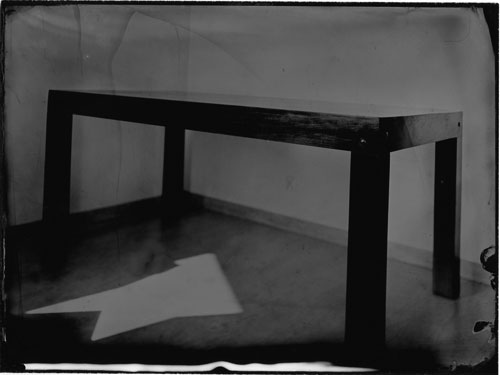
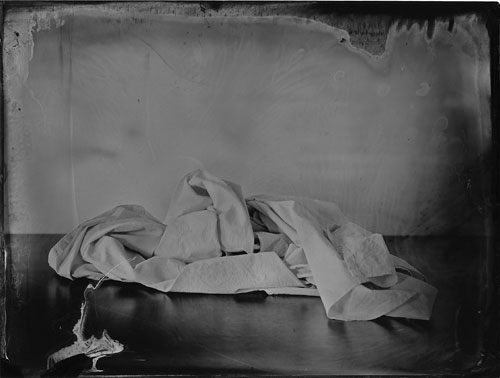
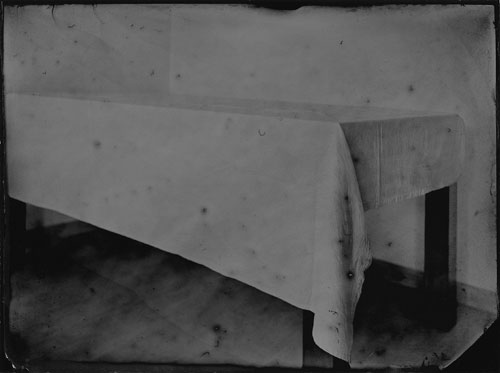
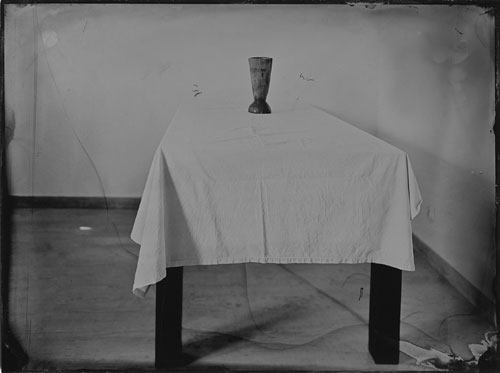
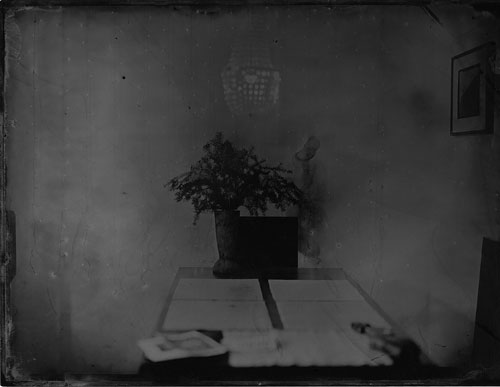
Copyright ©2009 Galeria FF 흟DK, Marek Szyryk, Marianna Micha흢owska